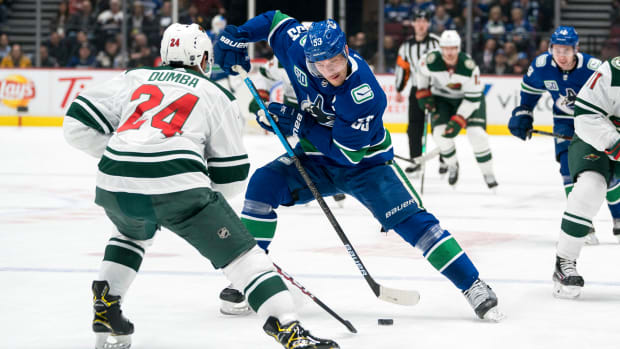New on Sports Illustrated: NHL Qualifying Round Playoff Preview: Canucks vs. Wild
The speedy Canucks clash with the stingy underdog Wild. Who will prevail: the youth or the wily vets?
VANCOUVER CANUCKS – By Brian Costello
Go back to season previews for 2019-20 and virtually every prognosticator tabbed the Canucks as needing another rebuilding season and surely out of the playoffs. Dig a little deeper, though, and you’ll see some of those soothsayers also added the footnote that Vancouver could be that one team that stuns the field and makes an enormous stride forward.
Trades by GM Jim Benning the past couple years brought in top-six forwards J.T. Miller, Tyler Toffoli and Tanner Pearson. Their pace of scoring is at the top of the charts in Vancouver. Add this cast to homegrown stars Elias Pettersson, Brock Boeser and Bo Horvat, plus the fast-improving Adam Gaudette and Jake Virtanen, and the Canucks have one of the deepest and most balanced lineups in the West.
The Canucks can get you in a variety of ways. Try to shut down the speed and puck movement of Pettersson and Boeser and the second and third wave will hit you. Seven Vancouver forwards had at least three power-play goals this season, while Toffoli surely would have gotten there with more runway.
The offensive dimension Quinn Hughes provided from the blueline was surprising only in the fact it came right away, as a 20-year-old rookie. He averaged almost 22 minutes of ice time per game, and his 3:48 of power-play time per outing ranked third among NHL defensemen.
Defensively, the Canucks bled shots, allowing 33.3 per game, fourth most in the NHL. Add that to the fact they were also second in blocked shots and you get the picture: the puck spends a lot of time in the Canucks’ zone. Vancouver was a bottom-10 team in Corsi percentage.
With Micheal Ferland sidelined most of the season, the Canucks didn’t have much of a physical deterrent. They’re a team that can be neutralized by pushing them around.
X-factor: Just when some Vancouver fans were anointing Thatcher Demko as the team’s new No. 1 goalie, this was the coming-out season for Jacob Markstrom. Always a plucky battler with more good games than bad games over the years, the 30-year-old took it to a new level this season. He was even a fringe name in the Vezina Trophy conversation when he went down with an injury Feb. 22, three weeks before the league shut down. The Canucks were fifth in the West and comfortably in the playoffs when Markstrom was sidelined. With him gone, they slid to eighth. With him healthy, the Canucks can roll with the best teams.

MINNESOTA WILD – By Jared Clinton
Two weeks before the trade deadline, GM Bill Guerin dealt Jason Zucker to the Pittsburgh Penguins. One week later, coach Bruce Boudreau was fired and replaced by Dean Evason. And on deadline day, the Wild reportedly flirted with a trade that would have sent top-line winger Zach Parise to the New York Islanders. However, despite all signs pointing to a teardown and rebuild, Guerin held firm that his intention was for the Wild to compete for a post-season spot. Against seemingly all odds, Minnesota managed to do exactly that.
The perception that the Wild are nothing more than a hanger-on is somewhat misguided, though. While it’s true they lack top-end firepower, the attack is greater than the sum of its parts. Driving the offense is a slew of veterans, including Parise, Eric Staal and Mats Zuccarello, but most impressive, particularly throughout the back half of the campaign, was Kevin Fiala. The 23-year-old bordered on unstoppable through February and into March, scoring at more than a point-per-game pace.
And with Ryan Suter and Jared Spurgeon guiding the defense, Minnesota has been far more unyielding defensively than its goals-against average suggests. No team allowed fewer scoring chances or high-danger chances against, and the Wild boasted the lowest expected goals-against rate in the NHL.
Unfortunately, the shell that had been provided to Minnesota’s goalies hasn’t been reflected in their play. Alex Stalock and Devan Dubnyk had a combined .902 save percentage, and the Wild’s overall SP (.897) was 29th in the NHL. Stalock was beginning to round into form down the stretch, however. He unseated Dubnyk following the all-star break and didn’t look back. Stalock is largely untested in post-season action with four career playoff games on his resume, but he has performed well when called upon, as his .931 SP can attest.
X-factor: Which version of Eric Staal shows up? Though he’s had a career resurgence in Minnesota, his last three trips to the post-season were fruitless. Dating back to the 2016 playoffs, during which he was a member of the New York Rangers, Staal has a single goal and three points in 15 games. That level of production is a far cry from his past as a playoff warrior. During the Hurricanes’ run to the 2006 title, Staal led players with 19 assists and 28 points. He followed that with a team-best 10 goals and 15 points in 18 games during Carolina’s 2009 conference final run. Rediscovering that old spark will increase the potential for a Wild upset.
Season series
Jan. 12, 2020: Canucks 4, Wild 1
Feb. 6, 2020: Wild 4, Canucks 2
Feb. 19, 2020: Wild 4, Canucks 3 (SO)
Schedule
Sunday, Aug. 2, 10:30 p.m.: Wild at Canucks
Tuesday, Aug. 4, 10:45 p.m.: Wild at Canucks
Thursday, Aug. 6, TBD: Canucks at Wild
Friday, Aug. 7, TBD: Canucks at Wild *
Sunday, Aug. 9, TBD: Wild at Canucks *
(All games listed in eastern time)
THE HOCKEY NEWS’ SERIES PICK: Canucks in four games
Get everything you need to know about this year’s post-season in THN’s Playoff Preview magazine! Read the issue on our Apple App (
https://apple.co/32vUMnA), Android App (https://bit.ly/2DV2ltN) or on Zinio (https://bit.ly/3jbPbsu).
Comments
Post a Comment